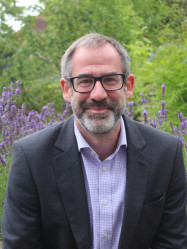Summary
Peter is Professor of Theory and Simulation of Materials, a post held jointly between the departments of Materials and Physics and associated with the Thomas Young Centre. His research interests focus on the development of new methods for performing first-principles quantum-mechanical simulations and their application to materials science, nanotechnology and biological systems.
Peter's work has mainly focussed on methods for large-scale simulations where the computational effort scales linearly with system-size. He is an author of the ONETEP code and was awarded the Maxwell Medal and Prize for Computational Physics by the Institute of Physics in 2010. He was elected to the Fellowship of the Royal Academy of Engineering in 2021.
Peter's interests have more recently expanded to include methods for simulating molecules and materials on emerging quantum computers, in collaboration with the Imperial Centre for Quantum Engineering, Science and Technology and Samsung Advanced Institute of Technology.
Peter studied Natural Sciences at Christ's College, Cambridge, specialising in Theoretical Physics, and completed his doctorate in the Theory of Condensed Matter group at the Cavendish Laboratory in 1998. After that he held the Thomas Nevile Research Fellowship at Magdalene College, the Ramon Jenkins Senior Research Fellowship at Sidney Sussex College and was a Royal Society University Research Fellow from 2005 until 2013. He joined Imperial College London in June 2007.
For more information, watch his inaugural lecture.
Selected Publications
Journal Articles
Charlton RJ, Fogarty R, Bogatko S, et al., 2018, Implicit and explicit host effects on excitons in pentacene derivatives, Journal of Chemical Physics, Vol:148, ISSN:0021-9606
Siroki G, Haynes PD, Lee DKK, et al., 2017, Protection of surface states in topological nanoparticles, Physical Review Materials, Vol:1, ISSN:2475-9953
Corsini NRC, Hine NDM, Haynes PD, et al., 2017, Unravelling the roles of size, ligands and pressure in the piezochromic properties of CdS nanocrystals, Nano Letters, Vol:17, ISSN:1530-6992, Pages:1042-1048
Siroki G, Lee DKK, Haynes PD, et al., 2016, Single-electron induced surface plasmons on a topological nanoparticle, Nature Communications, Vol:7, ISSN:2041-1723
Zuehlsdorff TJ, Haynes PD, Hanke F, et al., 2016, Solvent effects on electronic excitations of an organic chromophore, Journal of Chemical Theory and Computation, Vol:12, ISSN:1549-9626, Pages:1853-1861
Corsini NR, Zhang Y, Little WR, et al., 2015, Pressure-induced amorphization and a new high density amorphous metallic phase in matrix-free Ge nanoparticles, Nano Letters, Vol:15, ISSN:1530-6992, Pages:7334-7340
Zuehlsdorff TJ, Hine NDM, Spencer JS, et al., 2013, Linear-scaling time-dependent density-functional theory in the linear response formalism, Journal of Chemical Physics, Vol:139, ISSN:0021-9606
Haynes PD, Skylaris CK, Mostofi AA, et al., 2006, ONETEP: linear-scaling density-functional theory with local orbitals and plane waves, Physica Status Solidi B - Basic Solid State Physics, Vol:243, ISSN:0370-1972, Pages:2489-2499
Haynes PD, Payne MC, 1997, Localised spherical-wave basis set for O(N) total-energy pseudopotential calculations, Computer Physics Communications, Vol:102, ISSN:0010-4655, Pages:17-27

